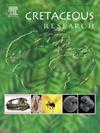沙特阿拉伯中部上白垩统演替的地球化学和区域地层学:阿拉伯板块前陆盆地形成的记录
IF 1.7
3区 地球科学
Q1 GEOLOGY
引用次数: 0
摘要
阿拉伯板块前陆盆地的形成及其晚白垩世的沉降史记录在其前隆起和后隆起的沉积演替中。通过涉及沉积学、地层学、生物地层学和地球化学的多学科方法,研究了沙特阿拉伯中部这一序列的暴露情况,以记录沉积体系的地层演化。该序列在其底部以三角洲、河口和开放海岸潮滩的Majma、Qibah和Malihah地层的硅质沉积层为标志。这些单元向上过渡到Aruma组,代表碳酸盐斜坡上的碳酸盐沉积。阿鲁玛组的坎帕尼亚-马斯特里赫特年龄与标志着坎帕尼亚-马斯特里赫特边界事件的负碳同位素偏移的出现相一致。从硅塑料到浅水碳酸盐的岩性转变标志着一个整体的海侵,在一个区域不整合之上,这与从Turonian到Maastrichtian的长期海平面上升相反。这是由于板块东部和东北部边缘蛇绿岩的逆冲导致挠曲沉降逐渐增加,迫使阿鲁玛组碳酸盐岩上移到不整合面上,并后退到前陆盆地的前隆起上。最大挠曲沉降表现为马斯特里赫特早期磷质缩合剖面的沉积,这也标志着蛇绿岩在板块边缘最远推进的时间。本研究显示了浅水碳酸盐岩体系作为前陆盆地沉降史记录者的能力。本文章由计算机程序翻译,如有差异,请以英文原文为准。
Geochemistry and regional stratigraphy of the Upper Cretaceous succession of central Saudi Arabia: A record of foreland basin inception on the Arabian Plate
The inception of a foreland basin on the Arabian Plate and its subsidence history during the Late Cretaceous are recorded in its forebulge and backbulge sedimentary succession. Exposures of this succession in central Saudi Arabia were examined through a multi-disciplinary approach involving sedimentology, stratigraphy, biostratigraphy, and geochemistry to document the stratigraphic evolution of the depositional system. The succession is marked at its base by deltaic, estuarine, and open-coast tidal flat siliciclastic deposits of the Majma, Qibah, and Malihah formations. These units transition upward into the Aruma Formation which represents carbonate deposition on a carbonate ramp. A Campanian–Maastrichtian age for the Aruma Formation is consistent with the appearance of a negative carbon isotope excursion marking the Campanian-Maastrichtian Boundary Event. The lithological shift from siliciclastics to shallow-water carbonates marks an overall transgression, over a regional unconformity, which is contrary to the documented long-term eustatic sea-level fall from the Turonian through Maastrichtian. This was driven by progressive increase in flexural subsidence due to ophiolite obduction over the plate's eastern and northeastern margins, forcing the Aruma Formation carbonates to onlap onto the unconformity and backstep over the forebulge of the foreland basin. The maximum flexural subsidence is manifested by the deposition of a phosphoritic condensed section in the earliest Maastrichtian, which also signals to the timing of the farthest advancement of the ophiolites over the plate's margins. This study showcases the capacity of shallow-water carbonate systems as recorders of subsidence history in foreland basins.
求助全文
通过发布文献求助,成功后即可免费获取论文全文。
去求助
来源期刊

Cretaceous Research
地学-地质学
CiteScore
4.10
自引率
19.00%
发文量
235
审稿时长
12 weeks
期刊介绍:
Cretaceous Research provides a forum for the rapid publication of research on all aspects of the Cretaceous Period, including its boundaries with the Jurassic and Palaeogene. Authoritative papers reporting detailed investigations of Cretaceous stratigraphy and palaeontology, studies of regional geology, and reviews of recently published books are complemented by short communications of significant new findings.
Papers submitted to Cretaceous Research should place the research in a broad context, with emphasis placed towards our better understanding of the Cretaceous, that are therefore of interest to the diverse, international readership of the journal. Full length papers that focus solely on a local theme or area will not be accepted for publication; authors of short communications are encouraged to discuss how their findings are of relevance to the Cretaceous on a broad scale.
Research Areas include:
• Regional geology
• Stratigraphy and palaeontology
• Palaeobiology
• Palaeobiogeography
• Palaeoceanography
• Palaeoclimatology
• Evolutionary Palaeoecology
• Geochronology
• Global events.
 求助内容:
求助内容: 应助结果提醒方式:
应助结果提醒方式:


